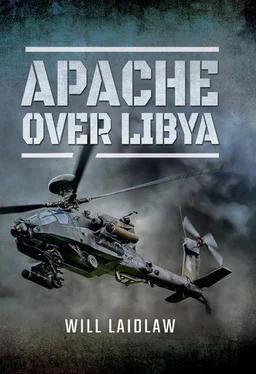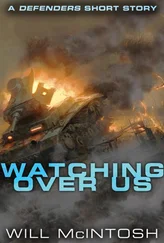On the inter-aircraft radio Jay told Nick what was going on and what was about to happen: ‘Technical at zero-two-zero, less than 2 kilometres, engaging now.’
Closing on the technical at over 100 knots gave Jay just two seconds to get his missile in the air; any delay would mean the Hellfire might not have time to boost away from the Apache and gather the laser energy to steer itself to the target. Fast-moving, close-in missile firing requires a deft touch and lightning quick decision-making. Recognizing his chance would be over in a heartbeat, he pulled the trigger and sent his sixth Hellfire of the night into the technical. It took less than four seconds to reach the target. As the missile struck the technical a concussive wave of energy and shrapnel washed through the trees. Jay instantly stepped out a field of view on the FLIR and saw the three men, their backs to the trees between them and the wreckage of their technical. At less than one kilometre from the mayhem Jay saw three more pro-Gad out of work.
‘Delta Hotel! Technical destroyed head left three-four-zero to avoid. Slowing to 80 knots for you to catch up.’ Big Shippers passed the good news on to Underdog One.
With the patrol linked up, but still with seven miles to run to the coast, the danger had not passed. The technical in the trees had got their collective adrenaline pumping and Underdog Two, still in the lead, had just one laser-guided Hellfire and a handful of 30mm left. More concerning was the fuel. Effectively running through the technical, rather than boxing around it, had saved a few pounds of fuel, but it was still going to require precision navigation from both Ocean and the Apaches to avoid embarrassment over the sea.
Their final leg took them out over the coast past a narrow eight-mile long spit of land providing a natural shelter to fishing boats, only a few miles from the Tunisian border. Jay could see several boats afloat directly on his flight path. Stepping out to the widest field of view with the FLIR, he could see small boats left and right too.
‘Coming right.’ Big Shippers weaved the patrol between the boats, and they left Libya behind. It seemed that early August was the big fishing season in western Libya. They had to treat each boat as a potential threat, keeping low to avoid them. The AWACS up high and SKASaC out at sea fed them a stream of avoiding manoeuvres over the radio. This meant they could not follow a straight line to Ocean and consequently edged towards their fuel reserves, eventually landing just as Big Shippers reported – spot on, to the pound.
In the flip-flop all four aircrew looked exhausted. It had been a long night and our longest mission. It was also our most successful in terms of targets struck – only slightly disappointing in that it was not a four-ship.
Doug Reid, doing his ammunition accounting, called across to Jay, ‘That was Hellfire 99 for the op so far, Jay.’
Another ten Hellfire could have been used at Okba, but that could wait for another day, we thought. The CO came in to see the debrief and immediately got on the phone to the CAOC to pass on the story. The third front was very much ours to deal with. We’d proved it again. But it had not been easy; it was risky, and the margins for error on the return leg had been very slim. We knew we were mortal, and pro-Gad only needed to be lucky once.
On the ground three scenarios now looked likely. One was that the FLF would turn the broken regime military over. The FLF would then march unhindered into the capital and take control. The second was a long bitter fight north, gaining and losing ground, eventually reaching Az-Zawiyah and Tripoli, where the agony of fighting an urban battle would turn the capital into a Stalingrad. The third, and least likely, scenario was that Gaddafi would realize he was losing and either surrender (very unlikely) or flee along with his inner circle, leaving the regime leaderless. The innumerable dynamics of war eventually yielded an amalgam of all three scenarios, but in early August any one of them looked likely. What was certain on 6 August 2011 was that a gaping hole had opened up, perhaps coincidentally, directly to the south of Okba. Within hours the FLF were on the march north. And pro-Gad were not there to stop them.
Chapter 14
Finishing with War – Only Two Average Days
After two weeks of unlaunched deck alerts, tuned to the fight but hearing the ‘do not fire’ orders from the decision men in the CAOC to jet man in the sky, we knew our work was done. There were no more opportunities without tightly coordinated and dynamic targeting. We needed live eyes on the target to launch and talk us on. With no boots on the ground, the eyes had to be airborne at the same time as us.
We tried it once with a UK Joint Terminal Attack Controller (JTAC) in a maritime patrol aircraft off the coast of Zlitan. The JTAC spent three hours watching tanks and artillery arriving in the vicinity of pro-Gad positions. I was on deck with Reuben and JB as the wing, all systems checked, all ready to go, Ocean primed, everyone on their silent timeline. In the aircraft we listened to the Strike net.
JTAC to Matrix: ‘Five Main Battle Tanks, three multi-launch rocket systems on trucks. All pointing east towards Zlitan.’
Me to John: ‘Yes, in just a minute we’ll get the signal to launch…’
Matrix: ‘Roger.’
JTAC: ‘They came from the west, from the pro-Gad lines.’
Me: ‘Ready for rotors…’
‘Roger. We are uncertain of the pattern of life. It is considered an ambiguous situation,’ came the view from Italy.
Me: ‘What?! He’s not making it up!’
JTAC: ‘I have been observing for three hours. I understand this pattern of life. This is my positive identification. These are pro-Gad targets! What do I need to do to get you to launch AH?’ His frustration loaded the transmission.
Me: ‘Three hours! Let’s launch!’
Matrix: ‘AH have been stood down. No target.’
Me: ‘What?!’
Silence. Darkness and silence. And, just west of Zlitan, 32 Brigade covered their retreat.
Back on Ocean I leant back in my seat, powered down the weapon systems and let my thoughts out: ‘That’s it. Our work is done. If they won’t launch us to that target we won’t do any more of this.’
A minute later Doug tapped on the canopy. ‘It’s a cancel! Stand down, no target!’ he yelled through the engine noise.
The targeting decisions made in the CAOC had been very sound in the preceding months. Now, with the front lines broken out and fighting springing up in new areas hourly, understanding the ground truth had changed. They could no longer huddle round reconnaissance photographs, reflect on legal advice and spend an afternoon arriving at a decision. The situation on the ground was changing quickly and the established method of target decision-making was no longer valid. The comfort of time had gone, and along with it went the certainty of being right. The decision men in the CAOC could either delegate or say ‘no’. They said ‘no’ and thus regained certainty.
What was once a clear picture of pro-Gad, front line and FLF was now one large contested space. Targets identified by reconnaissance in the morning had moved by midday, got engaged in fights, were abandoned, deserted or destroyed. The regime and the rebels had the same equipment, and there was no way of telling who was who except, perhaps, by spending time observing what they were doing. To launch strikes into this risked ruining the now tentative opportunity of success. NATO, who for months had stared at an impasse, was trying to make sense of the rebel advance and needed to put the brakes on air strikes until the hundreds of men in flying suits watching screens and holding meetings understood the ground.
Читать дальше












